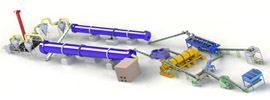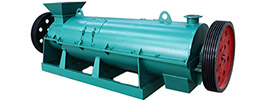Working Principle
-
Feeding & Extrusion
Powdery or granular raw materials enter the gap between two counter-rotating rollers via a feeding device. Under intense pressure and shear force, the material deforms and aggregates, gradually compressing into dense cakes.
-
Compression Molding
As the roller gap narrows, pressure increases continuously. The material is extruded through roller surface molds (e.g., circular, oval, square) into continuous strips.
-
Cutting & Screening
The strips are cut into preset lengths by a knife to form regular particles (e.g., flat spherical, almond-shaped). Target-sized particles are then separated via a screening system.
-
Molecular Binding Forces
Particle cohesion relies on molecular forces such as van der Waals forces, adsorption, crystal bridges, and embedded connections, eliminating the need for binders.
Technical Advantages
1. Energy Efficiency & Cost Reduction
- Dry-Process Ambient Temperature Technology: Eliminates drying steps, reducing subsequent drying costs by 30%-50%.
- Optimized Transmission System: Uses high-efficiency motors and gear structures, lowering energy consumption per unit output by 30% compared to traditional equipment.
- Low Reflux Ratio: Reflux material accounts for only ~15% of feed, minimizing waste.
2. Environmental Benefits
- Zero Waste Emissions: Sealed design reduces dust pollution, complying with environmental regulations.
- Binder-Free Process: Avoids exhaust emissions from drying binders, simplifying workflows.
3. Productivity & Flexibility
- High Throughput: Capacity ranges from 1-5 tons/hour, supporting 24/7 continuous operation (e.g., monthly output increased from 800 to 1,200 tons in one plant).
- Wide Raw Material Adaptability: Compatible with over 20 materials (e.g., ammonium nitrate, urea, potassium chloride), enabling rapid formula switching (30+ product combinations).
- Adjustable Particle Specifications: Customizable via mold replacement, pressure adjustment, and knife positioning to meet diverse demands (e.g., organic fertilizers, compound fertilizers, biofertilizers).
4. Equipment Reliability & Cost
- Compact Design: Low failure rate and maintenance costs (key components like rollers and knives are easily replaceable).
- Low Investment: Simplified process skips drying and reflux steps.
- Long Service Life: Built with high-strength alloy steel for wear and corrosion resistance.
5. Product Quality
- High-Quality Particles: Uniform shape and strength, with a qualification rate exceeding 95%.
- Multi-Industry Application: Widely used in fertilizers, pharmaceuticals, chemicals, and feed industries, particularly suitable for rare earth and potassium fertilizer granulation.
Comparison with Other Equipment
| Equipment Type |
Advantages |
Disadvantages |
| Disc Granulator |
High granulation rate (>93%), durable structure. |
Requires drying, high energy consumption, large footprint. |
| Steam Granulation |
Suitable for high-humidity materials. |
Needs binders, high subsequent drying costs, prone to caking. |
| Extrusion Granulator |
Ideal for polymer materials, high particle density. |
High energy consumption and costs, limited flexibility. |
Application Cases
- Organic Fertilizer Production: A plant processed kitchen waste into 500 tons/year of premium organic fertilizer, generating an additional $300,000 annual revenue.
- Biomass Energy: Corn straw converted into granular fuel, boosting annual capacity by 300% with products exported globally.
- Chemical Industry: Successfully applied to granulate over 20 materials (e.g., ammonium nitrate, urea), filling domestic gaps in rare earth compound fertilizer production.
Summary
The double-roller extrusion granulator stands out in fertilizer, organic waste, pharmaceutical, and chemical sectors due to its efficiency, energy savings, environmental compliance, and flexibility. It is ideal for enterprises prioritizing low costs, high output, and premium-quality granules.
 Send us a Email
Send us a Email Wulong Industrial Cluster
Wulong Industrial Cluster Have any question?
Have any question?



















